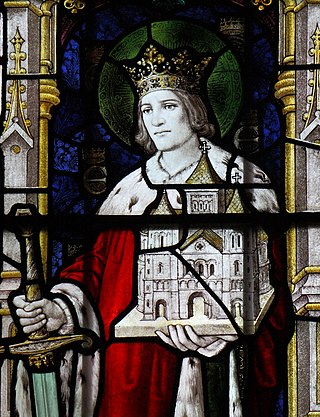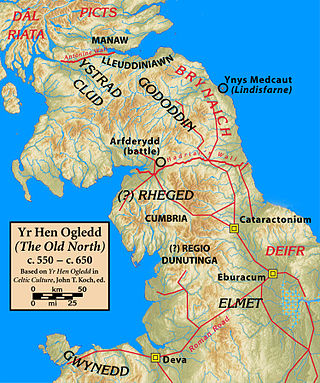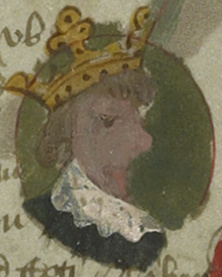Related Research Articles
The 610s decade ran from January 1, 610, to December 31, 619.

Year 613 (DCXIII) was a common year starting on Monday of the Julian calendar. The denomination 613 for this year has been used since the early medieval period, when the Anno Domini calendar era became the prevalent method in Europe for naming years.

Year 616 (DCXVI) was a leap year starting on Thursday of the Julian calendar. The denomination 616 for this year has been used since the early medieval period, when the Anno Domini calendar era became the prevalent method in Europe for naming years.

Bernicia was an Anglo-Saxon kingdom established by Anglian settlers of the 6th century in what is now southeastern Scotland and North East England.

Cadwallon ap Cadfan was the King of Gwynedd from around 625 until his death in battle. The son and successor of Cadfan ap Iago, he is best remembered as the King of the Britons who invaded and conquered Northumbria, defeating and killing its king, Edwin, prior to his own death in battle against Oswald of Bernicia. His conquest of Northumbria, which he held for a year or two after Edwin died, made him one of the last recorded Celtic Britons to hold substantial territory in eastern Britain until the rise of the Welsh House of Tudor. He was thereafter remembered as a national hero by the Britons and as a tyrant by the Anglo-Saxons of Northumbria.
Cadafael was King of Gwynedd. He came to the throne when his predecessor, King Cadwallon ap Cadfan, was killed in battle, and his primary notability is in having gained the disrespectful sobriquet Cadafael Cadomedd.

The Kingdom of Powys was a Welsh successor state, petty kingdom and principality that emerged during the Middle Ages following the end of Roman rule in Britain. It very roughly covered the northern two-thirds of the modern county of Powys and part of today's English West Midlands. More precisely, and based on the Romano-British tribal lands of the Ordovices in the west and the Cornovii in the east, its boundaries originally extended from the Cambrian Mountains in the west to include the modern West Midlands region of England in the east. The fertile river valleys of the Severn and Tern are found here, and this region is referred to in later Welsh literature as "the Paradise of Powys".

Camber, also Kamber, was the legendary first king of Cambria, according to the Geoffrey of Monmouth in the first part of his influential 12th-century pseudohistory Historia Regum Britanniae. According to Geoffrey, Cambria, the classical name for Wales, was named for him.

Gurgustius was a legendary king of the Britons as accounted by Geoffrey of Monmouth. He came to power in 788BC.
Dyfnwal Moelmud was accounted as an early king and lawmaker among the Welsh, credited with the codification of their standard units of measure. He also figures as a legendary king of the Britons in Geoffrey of Monmouth's pseudohistorical History of the Kings of the Britons.
Keredic was a legendary king of the Britons, as recounted by Geoffrey of Monmouth. The origin of Geoffrey's character is unknown, but he is not depicted as a Saxon. According to Geoffrey, Keredic's rule was so unpopular that the Saxons enlisted the aid of an army of Vandals from Ireland to drive him from his kingdom.
Cadfan ap Iago was King of Gwynedd. Little is known of the history of Gwynedd from this period, and information about Cadfan and his reign is minimal.
Iago ap Beli was King of Gwynedd. Little is known of him or his kingdom from this early era, with only a few anecdotal mentions of him in historical documents.
Cador is a legendary Duke of Cornwall, known chiefly through Geoffrey of Monmouth's pseudohistorical Historia Regum Britanniae and previous manuscript sources such as the Life of Carantoc. In Welsh genealogical records, he appears as Cado, the son of Cornish king Geraint. Early sources present him as a relative of King Arthur, though the details of their kinship are usually left unspecified.
Petroc Baladrddellt was a 7th-century King of Dumnonia.
Clemen ap Bledric was a 7th-century King of Dumnonia.

Caradoc Vreichvras was a semi-legendary ancestor to the kings of Gwent. He may have lived during the 5th or 6th century. He is remembered in the Matter of Britain as a Knight of the Round Table, under the names King Carados and Carados Briefbras.
References
- 1 2 Carew, Richard. The Survey of Cornwall And An Epistle Concerning the Excellencies of the English Tongue. London. 1769 p77
- ↑ Evans, Sebastian. Histories of the Kings of Britain, by Geoffry of Monmouth. 1904 p301
- ↑ Ashley, Mike The Mammoth Book of British Kings & Queens New York: Carroll & Graff 1998 ISBN 0-7867-0692-9 p118
- ↑ Snyder, Christopher A. The Britons Blackwell 2003 ISBN 0-631-22260-X p166
- ↑ Powell, David. The History of Wales written originally in British by Caradoc of Llancarfan. T. Evans, London. 1774 p17
- ↑ Mariboe, Knud. Encyclopaedia of the Celts. 1994, ISBN 87-985346-1-0
- ↑ Williams, John. Llyfr Baglan: or The Book of Baglan. Compiled Between the Years 1600 and 1607. Edited by Joseph Alfred Bradney. London: Mitchell, Hughes and Clarke, 1910. p80